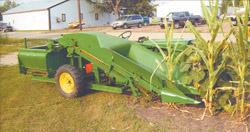 Don Perrion is a retired farmer and handyman who’s been building equipment for nearly 6 decades. Most of it he’s used on his own farm, some of it helped out neighbors, and others even found a broader market.
Don Perrion is a retired farmer and handyman who’s been building equipment for nearly 6 decades. Most of it he’s used on his own farm, some of it helped out neighbors, and others even found a broader market.
His latest invention, however, may be his most unusual yet. It’s a self-propelled single-row ear corn picker that’s 8 ft. wide, 16 ft. long and just 5 ft. tall. Don built his clever green picking machine from the ground up using parts from cars, trucks and old farm equipment, scrap metal from the junk pile, and new steel from a local metal shop.
The operator rides in comfort on a cushioned bright red chair while steering a single front wheel and adjusting foot and hydraulic controls within easy reach. Perrion’s miniature homemade picker is designed specifically to harvest standing ear corn in confined areas under the netting in game bird pens. The netting, which stays up year around, hangs from support poles that are 6 to 8 ft. tall.
Don started his project after learning that game bird producers don’t have a good way to harvest standing corn inside their bird pens. “One fellow I know has many acres of pens where he plants corn to give pheasants a natural habitat so they grow with limited human contact. After the birds are removed in the fall, the corn can be harvested, but doing that by hand is a time-consuming and expensive job.” Perrion answered that challenge by building his mini picker.
First he located a single row International pull-type ear corn picker that he says might have been sitting unused for 30 to 40 years. He salvaged the picking mechanism, which included the snapping rolls, gathering chains and drive components. A good dose of rust remover and old oil put them in working order. Then he cut apart the frame and adapted it to a lower mounting profile. He reconfigured the snouts and metal side dividers to fit 30-in. rows rather than the 40-in. spacing the picker was originally designed for. He scrapped out the hitch, wheels, husking bed and elevator.
Originally Perrion thought about mounting the picker unit on a car chassis, but discovered that wouldn’t be strong enough, small enough or low enough to the ground. Instead he built a new frame from 4-in. channel iron. It’s supported on the front by a single wheel from an old Versatile swather. The 15-in. rear wheels, mounted above the frame, are from another farm implement. The rig turns with a shaft and steering wheel from an old high boy sprayer.
Power comes from a 4-cylinder engine that once ran a self-propelled Deere swather. The engine mounts directly to the frame and is covered with custom-formed sheet metal. To the casual observer it looks almost like a small, factory-built tractor with a mounted picker. The engine shaft goes through a 4:1 belt reduction assembly before mating with a 4-speed transmission from an old Chevy truck. “First gear gives me an operating speed about as fast as a person can walk,” says Don, “and 4th gear has a top speed of about 15 mph. Braking is done with the original hand-operated emergency brake.” The transmission also produces 540 rpm power that runs the picker.
“I wanted a self-propelled and self-contained picker,” Don says, “so the corn delivery, transport and unloading were another key to the whole outfit.” Perrion achieved that by extending the gathering chains to move ear corn from the snapping rolls up a small incline chute to the back of the machine. There it’s dumped into a 25 bushel box that Perrion made by cutting an old manure spreader in half. He used the sides and front and built a new door for the back. He mounted the spreader sideways on his frame, then added a standard 6-in. flighted auger to fill the box evenly. He unloads the box with the original manure spreader apron chain, now powered by a hydraulic motor.
“The apron puts the corn in a nice pile that can be scooped into a combine for shelling or into another container for use as ear corn in a crib feeder,” Perrion says, noting that there’s no husking bed. It just pulls the ears off with snapping rolls.
“It took me about 300 hours to build, longer than what I figured when I started out, but the end result really does the job,” says Don. He pronounced the machine a success after picking sweet corn with it in August, 2013, and looks forward to harvesting ripe ear corn later in the fall.
1-800-834-9665
Home-Built Single Row Corn Picker Stands Just 5 Ft. Tall
FARM SHOW Magazine » Home-Built Single Row Corn Picker Stands Just 5 Ft. Tall
Home-Built Single Row Corn Picker Stands Just 5 Ft. Tall
